1. Mise Y, Sakamoto Y, Ishizawa T, Kaneko J, Aoki T, Hasegawa K, et al. A worldwide survey of the current daily practice in liver surgery. Liver Cancer. 2013; 2:55–66. PMID:
24159597.

2. Martin AN, Kerwin MJ, Turrentine FE, Bauer TW, Adams RB, Stukenborg GJ, et al. Blood transfusion is an independent predictor of morbidity and mortality after hepatectomy. J Surg Res. 2016; 206:106–112. PMID:
27916348.

3. Hallet J, Jayaraman S, Martel G, Ouellet JB, Lin Y, McCluskey S, et al. Patient blood management for liver resection: consensus statements using Delphi methodology. HPB (Oxford). 2019; 21:393–404. PMID:
30446290.

4. Bennett S, Baker LK, Martel G, Shorr R, Pawlik TM, Tinmouth A, et al. The impact of perioperative red blood cell transfusions in patients undergoing liver resection: a systematic review. HPB (Oxford). 2017; 19:321–330. PMID:
28161216.

5. Dhar VK, Wima K, Lee TC, Morris MC, Winer LK, Ahmad SA, et al. Perioperative blood transfusions following hepatic lobectomy: a national analysis of academic medical centers in the modern era. HPB (Oxford). 2019; 21:748–756. PMID:
30497896.

6. Lu Q, Zhang J, Gao WM, Lv Y, Zhang XF, Liu XM. Intraoperative blood transfusion and postoperative morbidity following liver resection. Med Sci Monit. 2018; 24:8469–8480. PMID:
30470732.

7. Lucas DJ, Schexneider KI, Weiss M, Wolfgang CL, Frank SM, Hirose K, et al. Trends and risk factors for transfusion in hepatopancreatobiliary surgery. J Gastrointest Surg. 2014; 18:719–728. PMID:
24323432.

8. Franchini M, Marano G, Veropalumbo E, Masiello F, Pati I, Candura F, et al. Patient blood management: a revolutionary approach to transfusion medicine. Blood Transfus. 2019; 17:191–195. PMID:
31246561.
9. Jung YK, Choi D. Patient blood management in hepatobiliary and pancreatic surgery. Hanyang Med Rev. 2018; 38:56–61.

10. Namgoong JM, Kim KH, Park GC, Jung DH, Song GW, Ha TY, et al. Comparison of laparoscopic versus open left hemihepatectomy for left-sided hepatolithiasis. Int J Med Sci. 2014; 11:127–133. PMID:
24465157.

11. Hwang DW, Han HS, Yoon YS, Cho JY, Kwon Y, Kim JH, et al. Laparoscopic major liver resection in Korea: a multicenter study. J Hepatobiliary Pancreat Sci. 2013; 20:125–130. PMID:
23001191.

12. Yoon YS, Han HS, Cho JY, Yoon CJ, Kim JH. Laparoscopic approach for treatment of multiple hepatocellular carcinomas. Surg Endosc. 2012; 26:3133–3140. PMID:
22538699.

13. Suh YS, Choi HS, Lee JS, Jang BW, Hwang J, Song MG, et al. Transfusion trends of knee arthroplasty in korea: a nationwide study using the Korean National Health Insurance Service Sample Data. Int J Environ Res Public Health. 2022; 19:5982. PMID:
35627518.

14. Suh YS, Lee JJ, Nho JH, Lee JJ, Won SH, Yang HJ. Transfusion trends in hip arthroplasty in Korea: a nationwide study by the Korean National Health Insurance Service. Transfusion. 2019; 59:2324–2333. PMID:
31022315.

15. Kim HO. Current state of blood management services in Korea. Ann Lab Med. 2022; 42:306–313. PMID:
34907100.

16. Moher D, Liberati A, Tetzlaff J, Altman DG. PRISMA Group. Preferred reporting items for systematic reviews and meta-analyses: the PRISMA statement. BMJ. 2009; 339:b2535. PMID:
19622551.

17. Kim SY, Park JE, Lee YJ, Seo HJ, Sheen SS, Hahn S, et al. Testing a tool for assessing the risk of bias for nonrandomized studies showed moderate reliability and promising validity. J Clin Epidemiol. 2013; 66:408–414. PMID:
23337781.

18. Nam S, Pritchard KT, Bae S, Hong I. Cross-national comparisons of cognitive and physical health in older adults across China, Japan, and Korea: a systematic review. Inquiry. 2021; 58:469580211062451. PMID:
34898332.
19. Higgins JP, Altman DG, Gøtzsche PC, Jüni P, Moher D, Oxman AD, et al. The Cochrane Collaboration’s tool for assessing risk of bias in randomised trials. BMJ. 2011; 343:d5928. PMID:
22008217.

20. Sterne JAC, Savović J, Page MJ, Elbers RG, Blencowe NS, Boutron I, et al. RoB 2: a revised tool for assessing risk of bias in randomised trials. BMJ. 2019; 366:l4898. PMID:
31462531.

21. Martel G, Baker L, Wherrett C, Fergusson DA, Saidenberg E, Workneh A, et al. Phlebotomy resulting in controlled hypovolaemia to prevent blood loss in major hepatic resections (PRICE-1): a pilot randomized clinical trial for feasibility. Br J Surg. 2020; 107:812–823. PMID:
31965573.

22. Gao X, Xiong Y, Huang J, Zhang N, Li J, Zheng S, et al. The effect of mechanical ventilation with low tidal volume on blood loss during laparoscopic liver resection: a randomized controlled trial. Anesth Analg. 2021; 132:1033–1041. PMID:
33060490.

23. Yu L, Sun H, Jin H, Tan H. The effect of low central venous pressure on hepatic surgical field bleeding and serum lactate in patients undergoing partial hepatectomy: a prospective randomized controlled trial. BMC Surg. 2020; 20:25. PMID:
32019557.

24. Bekki T, Abe T, Amano H, Hattori M, Kobayashi T, Nakahara M, et al. Impact of low skeletal muscle mass index and perioperative blood transfusion on the prognosis for HCC following curative resection. BMC Gastroenterol. 2020; 20:328. PMID:
33028209.

25. Cai J, Zheng J, Xie Y, Kirih MA, Jiang G, Liang Y, et al. A novel simple intra-corporeal Pringle maneuver for laparoscopic hemihepatectomy: how we do it. Surg Endosc. 2020; 34:2807–2813. PMID:
32206920.

26. Chen G, Tian F, Zhao X, Chen Y, Peng T, Cui J, et al. Perihilar hepatectomy for hepatolithiasis with compressed hilar bile duct induced by perihilar hyperplasia of liver. J Invest Surg. 2020; 33:505–513. PMID:
30543132.

27. Chen GX, Qi CY, Hu WJ, Wang XH, Hua YP, Kuang M, et al. Perioperative blood transfusion has distinct postsurgical oncologic impact on patients with different stage of hepatocellular carcinoma. BMC Cancer. 2020; 20:487. PMID:
32471389.

28. Chen TH, Yang HR, Jeng LB, Hsu SC, Hsu CH, Yeh CC, et al. Laparoscopic liver resection: experience of 436 cases in one center. J Gastrointest Surg. 2019; 23:1949–1956. PMID:
30421118.

29. Choi YI. The usefulness of the totally intra-corporeal pringle maneuver with Penrose drain tube during laparoscopic left side liver resection. Ann Hepatobiliary Pancreat Surg. 2020; 24:252–258. PMID:
32843589.

30. Clark J, Mavroeidis VK, Lemmon B, Briggs C, Bowles MJ, Stell DA, et al. Intention to treat laparoscopic versus open hemi-hepatectomy: a paired case-matched comparison study. Scand J Surg. 2020; 109:211–218. PMID:
31131722.

31. Cloyd JM, Mizuno T, Kawaguchi Y, Lillemoe HA, Karagkounis G, Omichi K, et al. Comprehensive complication index validates improved outcomes over time despite increased complexity in 3707 consecutive hepatectomies. Ann Surg. 2020; 271:724–731. PMID:
30339628.

32. D’Hondt M, Willems E, Parmentier I, Pottel H, De Meyere C, Vansteenkiste F, et al. Laparoscopic liver resection for liver tumours in proximity to major vasculature: a single-center comparative study. Eur J Surg Oncol. 2020; 46(4 Pt A):539–547. PMID:
31668978.

33. Hu M, Chen K, Zhang X, Li C, Song D, Liu R. Robotic, laparoscopic or open hemihepatectomy for giant liver haemangiomas over 10 cm in diameter. BMC Surg. 2020; 20:93. PMID:
32375738.

34. Huang Y, Zeng J, Liu T, Lin X, Guo P, Zeng J, et al. Prognostic significance of elevated preoperative serum CA125 levels after curative hepatectomy for hepatocellular carcinoma. Onco Targets Ther. 2020; 13:4559–4567. PMID:
32547086.
35. Jia J, Zhang J, Shao Q, Wang Y, Qian B, Hu T, et al. Efficacy of surgical treatment on different sizes of hepatitis B virus-related hepatocellular carcinoma and prognostic analysis. J BUON. 2020; 25:1866–1874. PMID:
33099926.
36. Ju M, Xu F, Zhao W, Dai C. Efficacy and factors affecting the choice of enucleation and liver resection for giant hemangioma: a retrospective propensity score-matched study. BMC Surg. 2020; 20:271. PMID:
33160352.

37. Kim HJ, Cho JY, Han HS, Yoon YS, Lee HW, Lee JS, et al. Improved outcomes of major laparoscopic liver resection for hepatocellular carcinoma. Surg Oncol. 2020; 35:470–474. PMID:
33096444.

38. Kim JH, Kim H. Modified liver hanging maneuver in laparoscopic major hepatectomy: the learning curve and evolution of indications. Surg Endosc. 2020; 34:2742–2748. PMID:
31712899.

39. Lee JY, Rho SY, Han DH, Choi JS, Choi GH. Unplanned conversion during minimally invasive liver resection for hepatocellular carcinoma: risk factors and surgical outcomes. Ann Surg Treat Res. 2020; 98:23–30. PMID:
31909047.

40. Machado MA, Makdissi F, Surjan R. Laparoscopic glissonean approach: making complex something easy or making suitable the unsuitable? Surg Oncol. 2020; 33:196–200. PMID:
31307848.

41. Saad MR, Choi Y, Han HS, Yoon YS, Cho JY, Lee JS, et al. Solo single-incision laparoscopic liver resection: a cohort series. ANZ J Surg. 2020; 90:1108–1111. PMID:
32378778.

42. Shen J, Ni Z, Qian Y, Wang B, Zheng S. Clinical prediction score for superficial surgical site infections: Real-life data from a retrospective single-centre analysis of 812 hepatectomies. Int Wound J. 2020; 17:16–20. PMID:
31646746.

43. Shin Y, Rhu J, Choi GS, Kim JM, Joh JW, Kwon CH. Feasibility of laparoscopic liver resection for liver cavernous hemangioma: a single-institutional comparative study. Ann Hepatobiliary Pancreat Surg. 2020; 24:137–143. PMID:
32457257.

44. Sucandy I, Attili A, Spence J, Bordeau T, Ross S, Rosemurgy A. The impact of body mass index on perioperative outcomes after robotic liver resection. J Robot Surg. 2020; 14:41–46. PMID:
30707422.

45. Tabath M, Lim C, Goumard C, Scatton O. Surgical glove technique for laparoscopic liver resection. J Gastrointest Surg. 2020; 24:1912–1919. PMID:
32270365.

46. Tai YH, Wu HL, Mandell MS, Tsou MY, Chang KY. The association of allogeneic blood transfusion and the recurrence of hepatic cancer after surgical resection. Anaesthesia. 2020; 75:464–471. PMID:
31573678.

47. Tee MC, Chen L, Peightal D, Franko J, Kim PT, Brahmbhatt RD, et al. Minimally invasive hepatectomy is associated with decreased morbidity and resource utilization in the elderly. Surg Endosc. 2020; 34:5030–5040. PMID:
31820156.

48. Tian YL, Ji JJ, Chen LN, Cui XL, Liu ST, Mao L, Qiu YD, Li BB. Risk factors for long-term prognosis of hepatocellular carcinoma patients after anatomic hepatectomy. World J Clin Cases. 2020; 8:713–722. PMID:
32149055.

49. Wang XH, Liao B, Hu WJ, Tu CX, Xiang CL, Hao SH, et al. Novel models predict postsurgical recurrence and overall survival for patients with hepatitis B virus-related solitary hepatocellular carcinoma ≤10 cm and without portal venous tumor thrombus. Oncologist. 2020; 25:e1552–e1561. PMID:
32663354.

50. Wang Y, Fang J, Lin L, Pan L, Nan J, Cui X, et al. Laparoscopic versus open hemihepatectomy: a 1:1 matched analysis. Ann Transl Med. 2020; 8:431. PMID:
32395475.

51. Yi Y, Weng J, Zhou C, Liu G, Ren N. Laparoscopic versus open left hemihepatectomy for hepatocellular carcinoma: a propensity score matching analysis. Transl Cancer Res. 2020; 9:5484–5492. PMID:
35117913.

52. Zhang Y, Dou C, Wu W, Liu J, Jin L, Hu Z, et al. Total laparoscopic versus open radical resection for hilar cholangiocarcinoma. Surg Endosc. 2020; 34:4382–4387. PMID:
31664578.

53. Zhou JM, He XG, Wang M, Zhao YM, Shu L, Wang LR, et al. Enhanced recovery after surgery program in the patients undergoing hepatectomy for benign liver lesions. Hepatobiliary Pancreat Dis Int. 2020; 19:122–128. PMID:
31983674.

54. Al Khaldi M, Gryspeerdt F, Carrier FM, Bouchard C, Simoneau È, Rong Z, et al. Effect of intraoperative hypovolemic phlebotomy on transfusion and clinical outcomes in patients undergoing hepatectomy: a retrospective cohort study. Can J Anaesth. 2021; 68:980–990. PMID:
33945107.

55. Aoki T, Kubota K, Matsumoto T, Nitta H, Otsuka Y, Wakabayashi G, et al. Safety assessment of laparoscopic liver resection: a project study of the Endoscopic Liver Surgery Study Group of Japan. J Hepatobiliary Pancreat Sci. 2021; 28:470–478. PMID:
33609320.

56. Bednarsch J, Czigany Z, Lurje I, Trautwein C, Lüdde T, Strnad P, et al. Intraoperative transfusion of fresh frozen plasma predicts morbidity following partial liver resection for hepatocellular carcinoma. J Gastrointest Surg. 2021; 25:1212–1223. PMID:
32495137.

57. Boillot O, Cayot B, Guillaud O, Crozet-Chaussin J, Hervieu V, Valette PJ, et al. Partial major hepatectomy with cyst fenestration for polycystic liver disease: indications, short and long-term outcomes. Clin Res Hepatol Gastroenterol. 2021; 45:101670. PMID:
33722781.

58. Fagenson AM, Gleeson EM, Nabi F, Lau KN, Pitt HA. When does a Pringle Maneuver cause harm? HPB (Oxford). 2021; 23:587–594. PMID:
32933844.

59. Galun D, Bogdanovic A, Zivanovic M, Zuvela M. Short- and long-term outcomes after hepatectomy in elderly patients with hepatocellular carcinoma: an analysis of 229 cases from a developing country. J Hepatocell Carcinoma. 2021; 8:155–165. PMID:
33791251.

60. Goh BK, Syn N, Lee SY, Koh YX, Teo JY, Kam JH, et al. Impact of liver cirrhosis on the difficulty of minimally-invasive liver resections: a 1:1 coarsened exact-matched controlled study. Surg Endosc. 2021; 35:5231–5238. PMID:
32974782.

61. Hobeika C, Cauchy F, Fuks D, Barbier L, Fabre JM, Boleslawski E, et al. Laparoscopic versus open resection of intrahepatic cholangiocarcinoma: nationwide analysis. Br J Surg. 2021; 108:419–426. PMID:
33793726.
62. Hue JJ, Katayama E, Markt SC, Rothermel LD, Hardacre JM, Ammori JB, et al. Association between operative approach and venous thromboembolism rate following hepatectomy: a propensity-matched analysis. J Gastrointest Surg. 2021; 25:2778–2787. PMID:
33236321.

63. Inoue Y, Ishii M, Fujii K, Kitada K, Kuramoto T, Takano Y, et al. The effects of allogeneic blood transfusion in hepatic resection. Am Surg. 2021; 87:228–234. PMID:
32927956.

64. Ke Q, Wang L, Lin Z, Lou J, Zheng S, Bi X, et al. Prognostic value of lymph node dissection for intrahepatic cholangiocarcinoma patients with clinically negative lymph node metastasis: a multi-center study from China. Front Oncol. 2021; 11:585808. PMID:
33777738.

65. Kim JM, Rhu J, Ha SY, Choi GS, Kwon CH, Kim G, et al. Realization of improved outcomes following liver resection in hepatocellular carcinoma patients aged 75 years and older. Ann Surg Treat Res. 2021; 101:257–265. PMID:
34796141.

66. Li H, Li J, Ren B, Wang J, Xu L, Wang G, Wu H. Parenchyma-sparing hepatectomy improves salvageability and survival for solitary small intrahepatic cholangiocarcinoma. HPB (Oxford). 2021; 23:882–888. PMID:
33187828.

67. Li J, Huang L, Liu C, Qiu M, Yan J, Yan Y, et al. Risk factors and clinical outcomes of extrahepatic recurrence in patients with post-hepatectomy recurrent hepatocellular carcinoma. ANZ J Surg. 2021; 91:1174–1179. PMID:
33724680.

68. Lopez-Lopez V, Brusadin R, López-Conesa A, Capel A, Navarro-Barrios Á, Cayuela V, et al. Preoperative transarterial chemoembolization for laparoscopic liver resection in Child A cirrhotic patients with hepatocellular carcinoma. Langenbecks Arch Surg. 2021; 406:763–771. PMID:
33411038.

69. Lv X, Zhang L, Yu H, Yu X. Laparoscopic hepatectomy for hepatocellular carcinoma: short- and long-term outcomes with blood loss. Transl Cancer Res. 2021; 10:4303–4315. PMID:
35116289.

70. Machado MA, Lobo-Filho MM, Mattos BH, Ardengh AO, Makdissi FF. Robotic liver resection: report of the first 50 cases. Arq Gastroenterol. 2021; 58:514–519. PMID:
34909859.

71. Mahamid A, Fenig Y, Amodeo S, Facciuto L, Vonahrens D, Sulimani O, et al. Limited upper midline incision for major hepatectomy in adults: safety and feasibility. Turk J Surg. 2021; 37:379–386. PMID:
35677482.

72. Matsumoto M, Yanaga K, Shiba H, Wakiyama S, Sakamoto T, Futagawa Y, et al. Treatment of intrahepatic recurrence after hepatectomy for hepatocellular carcinoma. Ann Gastroenterol Surg. 2021; 5:538–552. PMID:
34337303.

73. Matsuo Y, Nomi T, Hokuto D, Yoshikawa T, Kamitani N, Sho M. Pulmonary complications after laparoscopic liver resection. Surg Endosc. 2021; 35:1659–1666. PMID:
32285208.

74. Ninh KV, Nguyen NQ, Trinh SH, Pham AG, Doan TN. The application of selective hepatic inflow vascular occlusion with anterior approach in liver resection: effectiveness in managing major complications and long-term survival. Int J Hepatol. 2021; 2021:6648663. PMID:
34007489.

75. Peng T, Wang L, Cui H, Li X, Liu M, Yu J, et al. Impact of perioperative allogeneic blood transfusion on the long-term prognosis of patients with different stage tumors after radical resection for hepatocellular carcinoma. Eur J Surg Oncol. 2021; 47(3 Pt B):620–627. PMID:
32988700.

76. Reese T, Pagel G, Bause BA, von Rittberg Y, Wagner KC, Oldhafer KJ. Complex liver resections for intrahepatic cholangiocarcinoma. J Clin Med. 2021; 10:1672. PMID:
33924732.

77. Ryu T, Takami Y, Wada Y, Sasaki S, Imamura H, Ureshino H, et al. Combined hepatectomy and microwave ablation for multifocal hepatocellular carcinoma: long-term outcomes and prognostic factors. Asian J Surg. 2021; 44:186–191. PMID:
32473893.

78. Shehta A, Farouk A, Fouad A, Aboelenin A, Elghawalby AN, Said R, et al. Post-hepatectomy liver failure after hepatic resection for hepatocellular carcinoma: a single center experience. Langenbecks Arch Surg. 2021; 406:87–98. PMID:
32778915.

79. Shin H, Cho JY, Han HS, Yoon YS, Lee HW, Lee JS, et al. Risk factors and long-term implications of unplanned conversion during laparoscopic liver resection for hepatocellular carcinoma located in anterolateral liver segments. J Minim Invasive Surg. 2021; 24:191–199. PMID:
35602860.

80. Sim JH, Kim SH, Jun IG, Kang SJ, Kim B, Kim S, et al. The association between prognostic nutritional index (PNI) and intraoperative transfusion in patients undergoing hepatectomy for hepatocellular carcinoma: a retrospective cohort study. Cancers (Basel). 2021; 13:2508. PMID:
34063772.

81. Takata H, Hirakata A, Ueda J, Yokoyama T, Maruyama H, Taniai N, et al. Prediction of portal vein thrombosis after hepatectomy for hepatocellular carcinoma. Langenbecks Arch Surg. 2021; 406:781–789. PMID:
33640991.

82. Vandermeulen M, Lim C, Goumard C, Scatton O. Standardized technique of selective left liver vascular exclusion during laparoscopic liver resection for benign and malignant tumors. J Gastrointest Surg. 2021; 25:2720–2725. PMID:
34131863.

83. Villagomez D, Shah M, Marti F, Orozco G, Davenport D, Gupta M, et al. Hepatic steatosis is associated with an increased risk of postoperative infections and perioperative transfusion requirements in patients undergoing hepatectomy. World J Surg. 2021; 45:3654–3659. PMID:
34546385.

84. Wang JC, Hou JY, Chen JC, Xiang CL, Mao XH, Yang B, et al. Development and validation of prognostic nomograms for single large and huge hepatocellular carcinoma after curative resection. Eur J Cancer. 2021; 155:85–96. PMID:
34371445.

85. Wang L, Lin N, Lin K, Xiao C, Wang R, Chen J, et al. The clinical value of postoperative transarterial chemoembolization for resectable patients with intermediate hepatocellular carcinoma after radical hepatectomy: a propensity score-matching study. J Gastrointest Surg. 2021; 25:1172–1183. PMID:
32440804.

86. Zhao Z, Yin Z, Pan L, Li C, Hu M, Lau WY, et al. Robotic hepatic resection in postero-superior region of liver. Updates Surg. 2021; 73:1007–1014. PMID:
33030697.

87. Zheng J, Feng X, Liang Y, Cai J, Shi Z, Kirih MA, et al. Safety and feasibility of laparoscopic liver resection for hepatocellular carcinoma with clinically significant portal hypertension: a propensity score-matched study. Surg Endosc. 2021; 35:3267–3278. PMID:
32632488.

88. Zhou Y, Ouyang J, Wang Z, Chen X, Zhu R, Li Q, et al. A novel internal cold circulation radiofrequency-assisted device for liver transection. Int J Hyperthermia. 2021; 38:308–315. PMID:
33627010.

89. Baumgartner R, Gilg S, Björnsson B, Hasselgren K, Ghorbani P, Sauter C, et al. Impact of post-hepatectomy liver failure on morbidity and short- and long-term survival after major hepatectomy. BJS Open. 2022; 6:zrac097. PMID:
35849062.

90. Cai JP, Chen W, Chen LH, Wan XY, Lai JM, Yin XY. Comparison between robotic-assisted and laparoscopic left hemi-hepatectomy. Asian J Surg. 2022; 45:265–268. PMID:
34120821.

91. Cao B, Hao P, Guo W, Ye X, Li Q, Su X, et al. A predictive model for blood transfusion during liver resection. Eur J Surg Oncol. 2022; 48:1550–1558. PMID:
35090795.

92. Cipriani F, Fiorentini G, Magistri P, Fontani A, Menonna F, Annecchiarico M, et al. Pure laparoscopic versus robotic liver resections: Multicentric propensity score-based analysis with stratification according to difficulty scores. J Hepatobiliary Pancreat Sci. 2022; 29:1108–1123. PMID:
34291591.

93. Dong Z, Fang K, Sui C, Guo J, Dai B, Geng L, et al. The surgical outcomes and risk factors of giant hepatic haemangiomas: a single centre experience. BMC Surg. 2022; 22:278. PMID:
35843944.

94. Durán M, Briceño J, Padial A, Anelli FM, Sánchez-Hidalgo JM, Ayllón MD, et al. Short-term outcomes of robotic liver resection: an initial single-institution experience. World J Hepatol. 2022; 14:224–233. PMID:
35126850.
95. Fok AJ, She WH, Ma KW, Tsang SH, Dai WC, Chan AC, et al. Adjuvant transarterial chemotherapy for margin-positive resection of hepatocellular carcinoma-a propensity score matched analysis. Langenbecks Arch Surg. 2022; 407:245–257. PMID:
34406489.

96. Hawksworth J, Radkani P, Nguyen B, Belyayev L, Llore N, Holzner M, et al. Improving safety of robotic major hepatectomy with extrahepatic inflow control and laparoscopic CUSA parenchymal transection: technical description and initial experience. Surg Endosc. 2022; 36:3270–3276. PMID:
34370124.

97. Herman P, Fonseca GM, Coelho FF, Kruger JA, Makdissi FF, Jeismann VB, et al. Two decades of liver resection with a multidisciplinary approach in a single institution: what has changed?: analysis of 1409 cases. Clinics (Sao Paulo). 2022; 77:100088. PMID:
35901605.
98. Imai E, Morohashi Y, Mishima K, Ozaki T, Igarashi K, Wakabayashi G. A goal-directed therapy protocol for preventing acute kidney injury after laparoscopic liver resection: a retrospective observational cohort study. Surg Today. 2022; 52:1262–1274. PMID:
35044519.

99. Jo SJ, Rhu J, Kim JM, Choi GS, Joh JW. Indications for open hepatectomy in the era of laparoscopic liver resection: a high volume single institutional study. J Liver Cancer. 2022; 22:146–157. PMID:
37383410.

100. Jo Y, Cho JY, Han HS, Yoon YS, Lee HW, Lee JS, et al. Development and validation of a difficulty scoring system for laparoscopic liver resection to treat hepatolithiasis. Medicina (Kaunas). 2022; 58:1847. PMID:
36557049.

101. Kabir T, Syn N, Koh YX, Teo JY, Chung AY, Chan CY, et al. Impact of tumor size on the difficulty of minimally invasive liver resection. Eur J Surg Oncol. 2022; 48:169–176. PMID:
34420824.

102. Kaibori M, Ichihara N, Miyata H, Kakeji Y, Nanashima A, Kitagawa Y, et al. Surgical outcomes of laparoscopic versus open repeat liver resection for liver cancers: a report from a nationwide surgical database in Japan. J Hepatobiliary Pancreat Sci. 2022; 29:833–842. PMID:
35445565.

103. Kim JM, Rhu J, Ha SY, Choi GS, Kwon CH, Joh JW. Hepatectomy outcomes in patients with hepatitis C virus-related hepatocellular carcinoma with or without cirrhosis. Ann Surg Treat Res. 2022; 102:1–9. PMID:
35071114.

104. Lei Z, Cheng N, Si A, Yang P, Guo G, Ma W, et al. A novel nomogram for predicting postoperative liver failure after major hepatectomy for hepatocellular carcinoma. Front Oncol. 2022; 12:817895. PMID:
35359352.

105. Loncar Y, Tartrat N, Lastennet D, Lemoine L, Vaillant JC, Savier E, et al. Pulmonary infection after hepatic resection: associated factors and impact on outcomes. Clin Res Hepatol Gastroenterol. 2022; 46:101733. PMID:
34146724.

106. Luo L, He Y, Zhu G, Xiao Y, Song S, Ge X, et al. Hepatectomy after conversion therapy for initially unresectable HCC: what is the difference? J Hepatocell Carcinoma. 2022; 9:1353–1368. PMID:
36578526.

107. Miyata T, Hayashi H, Yamashita YI, Matsumura K, Higashi T, Imai K, et al. The impact of histologic liver inflammation on oncology and the prognosis of patients undergoing hepatectomy for hepatocellular carcinoma. Ann Surg Oncol. 2022; 29:893–902. PMID:
34595665.

108. Nakada S, Otsuka Y, Ishii J, Maeda T, Kubota Y, Matsumoto Y, et al. Predictors of a difficult Pringle maneuver in laparoscopic liver resection and evaluation of alternative procedures to assist bleeding control. Surg Today. 2022; 52:1688–1697. PMID:
35767070.

109. Nanashima A, Hiyoshi M, Imamura N, Yano K, Hamada T, Kitamura E, et al. Liver hanging maneuver is suitable in major hepatectomy for liver malignancies over 5 cm. Turk J Surg. 2022; 38:215–220. PMID:
36846068.

110. Notake T, Shimizu A, Kubota K, Sugenoya S, Hosoda K, Hayashi H, et al. Right kidney position for laparoscopic liver resection of tumors located in the posterosuperior region. Surg Laparosc Endosc Percutan Tech. 2022; 32:621–626. PMID:
36130715.

111. Osei-Bordom D, Hall L, Hodson J, Joshi K, Austen L, Bartlett D, et al. Impact of frailty on short-term outcomes after laparoscopic and open hepatectomy. World J Surg. 2022; 46:2444–2453. PMID:
35810214.

112. Rahimli M, Perrakis A, Gumbs AA, Andric M, Al-Madhi S, Arend J, et al. The LiMAx Test as selection criteria in minimally invasive liver surgery. J Clin Med. 2022; 11:3018. PMID:
35683406.

113. Schmelzle M, Feldbrügge L, Ortiz Galindo SA, Moosburner S, Kästner A, Krenzien F, et al. Robotic vs. laparoscopic liver surgery: a single-center analysis of 600 consecutive patients in 6 years. Surg Endosc. 2022; 36:5854–5862. PMID:
35641702.

114. Tan H, Zhou R, Liu L, Si S, Sun Y, Xu L, et al. Comparison of efficacy and safety of laparoscopic and open enucleation for liver hemangioma in the right hemi liver: a retrospective cohort study. Ann Transl Med. 2022; 10:764. PMID:
35965786.

115. Tanemura A, Mizuno S, Maeda K, Shinkai T, Ito T, Hayasaki A, et al. Resection type is a predictor of postoperative complications in laparoscopic partial liver resection. Surg Endosc. 2022; 36:9054–9063. PMID:
35831677.

116. Vining CC, Kuchta K, Al Abbas AI, Hsu PJ, Paterakos P, Schuitevoerder D, et al. Bile leak incidence, risk factors and associated outcomes in patients undergoing hepatectomy: a contemporary NSQIP propensity matched analysis. Surg Endosc. 2022; 36:5710–5723. PMID:
35467144.

117. Wang J, Wang W, Chen X, Ma D, Du G, Xia T, et al. Laparoscopic versus open hepatectomy for intrahepatic cholangiocarcinoma in patients aged 60 and older: a retrospective cohort study. World J Surg Oncol. 2022; 20:396. PMID:
36510298.

118. Wu X, Zeng N, Hu H, Pan M, Jia F, Wen S, et al. Preliminary exploration on the efficacy of augmented reality-guided hepatectomy for hepatolithiasis. J Am Coll Surg. 2022; 235:677–688. PMID:
36106869.

119. Xu L, Xu Y, Lı G, Yang B. Effect of perioperative factors on the prognosis of patients with hepatocellular carcinoma who underwent hepatectomy. Turk J Med Sci. 2022; 52:1067–1074. PMID:
36326411.

120. Xu LN, Xu YY, Li GP, Yang B. Individualized risk estimation for postoperative pulmonary complications after hepatectomy based on perioperative variables. World J Gastrointest Surg. 2022; 14:685–695. PMID:
36158277.

121. Yang J, Chen K, Zheng C, Chen K, Lin J, Meng Q, et al. Impact of sarcopenia on outcomes of patients undergoing liver resection for hepatocellular carcinoma. J Cachexia Sarcopenia Muscle. 2022; 13:2383–2392. PMID:
35854105.

122. Yang SY, Yan ML, Duan YF, Feng JK, Ye JZ, Xiang YJ, et al. Perioperative and long-term survival outcomes of laparoscopic versus laparotomic hepatectomy for BCLC stages 0-A hepatocellular carcinoma patients associated with or without microvascular invasion: a multicenter, propensity score matching analysis. Hepatol Int. 2022; 16:892–905. PMID:
35704267.

123. Yang Y, Peng Y, Chen K, Wei Y, Li B, Liu F. Laparoscopic liver resection with “ultrasonic scalpel mimic CUSA” technique. Surg Endosc. 2022; 36:8927–8934. PMID:
35672503.

124. Zhang X, Huang Z, Lu H, Yang X, Cao L, Wen Z, et al. Identification of resection plane for anatomical liver resection using ultrasonography-guided needle insertion. Front Surg. 2023; 9:1035315. PMID:
36756661.

125. Latchana N, Hirpara DH, Hallet J, Karanicolas PJ. Red blood cell transfusion in liver resection. Langenbecks Arch Surg. 2019; 404:1–9.

126. Chen FL, Wang YY, Liu W, Xing BC. Prognostic factors in colorectal liver metastases patients with various tumor numbers treated by liver resection: a single-center, retrospective study. World J Surg Oncol. 2022; 20:237. PMID:
35854361.

127. Lyu X, Qiao W, Li D, Leng Y. Impact of perioperative blood transfusion on clinical outcomes in patients with colorectal liver metastasis after hepatectomy: a meta-analysis. Oncotarget. 2017; 8:41740–41748. PMID:
28410243.

128. Masatsune S, Kimura K, Kashiwagi S, En W, Okazaki Y, Maeda K, et al. Impact of intraoperative blood loss and blood transfusion on the prognosis of colorectal liver metastasis following curative resection. Anticancer Res. 2021; 41:5617–5623. PMID:
34732434.
129. Moggia E, Rouse B, Simillis C, Li T, Vaughan J, Davidson BR, et al. Methods to decrease blood loss during liver resection: a network meta-analysis. Cochrane Database Syst Rev. 2016; 10:CD010683. PMID:
27797116.

130. Jayaraman T, Lee YY, Chan WK, Mahadeva S. Epidemiological differences of common liver conditions between Asia and the West. JGH Open. 2019; 4:332–339. PMID:
32514433.

131. Choo SP, Tan WL, Goh BK, Tai WM, Zhu AX. Comparison of hepatocellular carcinoma in Eastern versus Western populations. Cancer. 2016; 122:3430–3446. PMID:
27622302.

132. Rao A, Rao G, Ahmed I. Laparoscopic or open liver resection?: let systematic review decide it. Am J Surg. 2012; 204:222–231. PMID:
22245507.

133. Yin Z, Fan X, Ye H, Yin D, Wang J. Short- and long-term outcomes after laparoscopic and open hepatectomy for hepatocellular carcinoma: a global systematic review and meta-analysis. Ann Surg Oncol. 2013; 20:1203–1215. PMID:
23099728.
134. Wang ZY, Chen QL, Sun LL, He SP, Luo XF, Huang LS, et al. Laparoscopic versus open major liver resection for hepatocellular carcinoma: systematic review and meta-analysis of comparative cohort studies. BMC Cancer. 2019; 19:1047. PMID:
31694596.
135. Koo BN, Kwon MA, Kim SH, Kim JY, Moon YJ, Park SY, et al. Korean clinical practice guideline for perioperative red blood cell transfusion from Korean Society of Anesthesiologists. Korean J Anesthesiol. 2019; 72:91–118. PMID:
30513567.
136. Kim H, Ko SY, Gwon JG. Trends of blood transfusion according to diseases in Korea: a 10-year nationwide cohort study. Transfus Med Hemother. 2022; 50:135–143. PMID:
37066054.
137. Kim BH, Park JW. Epidemiology of liver cancer in South Korea. Clin Mol Hepatol. 2018; 24:1–9. PMID:
29249129.
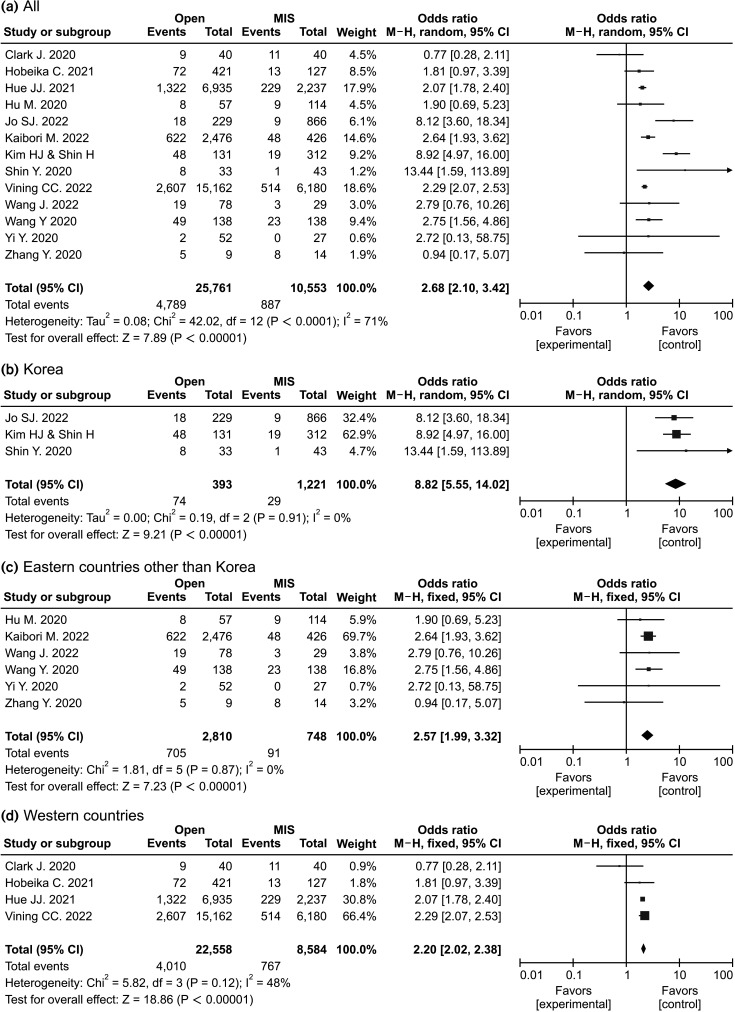
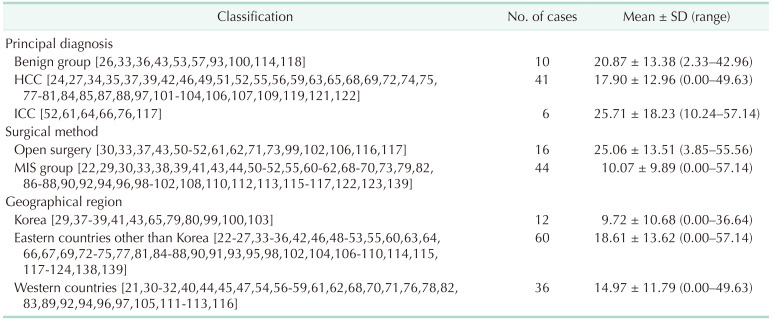
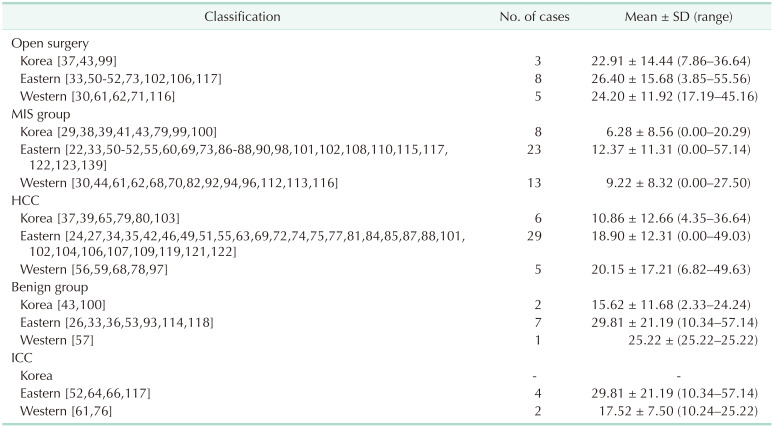




 PDF
PDF Citation
Citation Print
Print



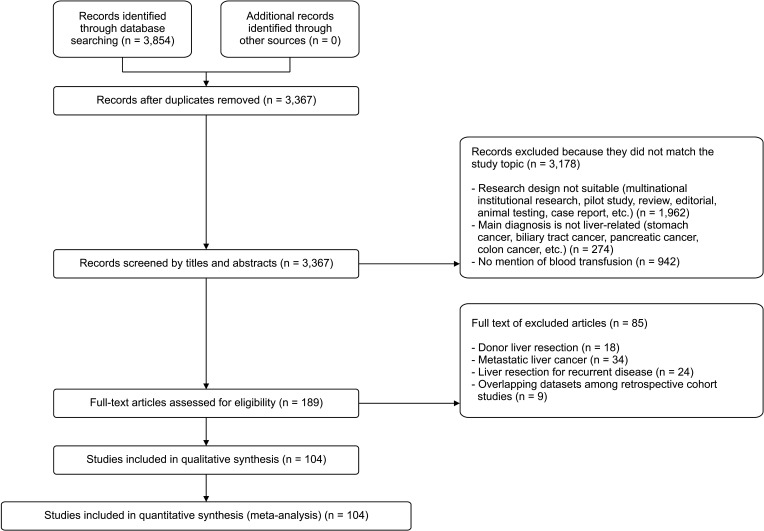
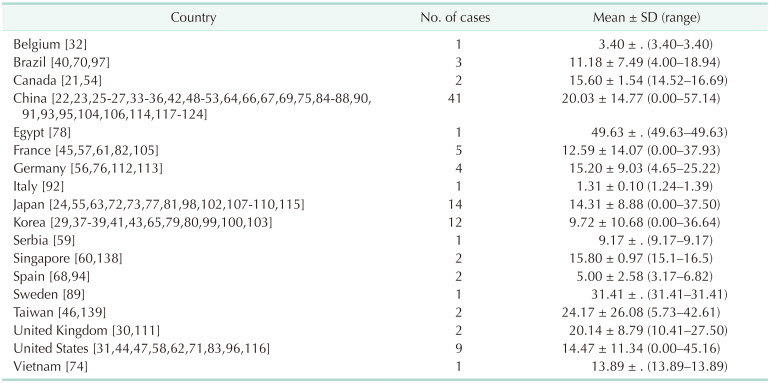
 XML Download
XML Download